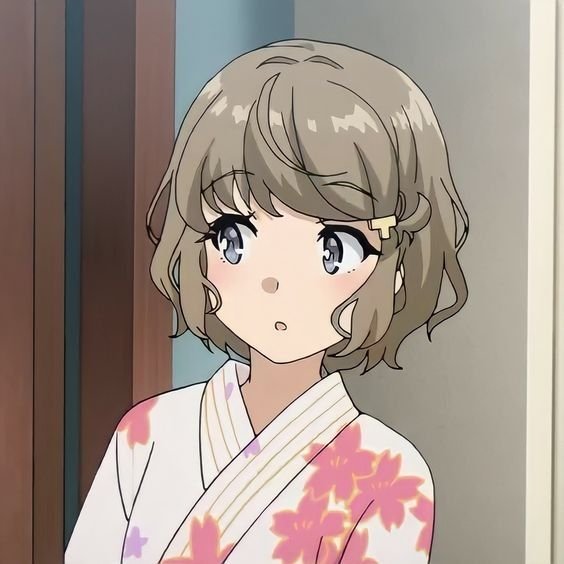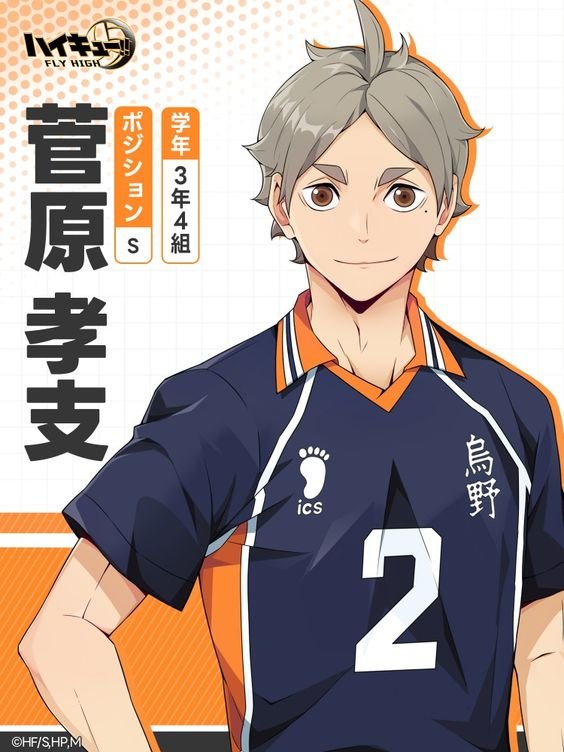
Tomoe Koga
Tomoe Koga |
|
|---|---|
 |
|
| Kana: | 古賀 朋絵 |
| Rōmaji: | Koga Tomoe |
| Characteristics | |
| Age: | 16 |
| Gender: | Female |
| Height: | 4’11” (152 cm) |
| Personal Status | |
| Status: | Alive |
| Birthdate: | May 23, 1998 (Gemini) |
| Occupation: |
|
| Year: |
|
| Affiliation: |
|
| Debut | |
| Anime: | Episode 02 |
| Light Novel: | Volume 01 |
| Portrayal | |
| Japanese: | Nao Tōyama |
| English: | Lizzie Freeman |
| “ | ” | |
|
— Tomoe Koga
|
||
Appearance

Tomoe full apperance.
Tomoe Koga is a petite girl with fluffy beige-blonde hair cut into a stylish bob, complemented by striking blue eyes. A distinctive T-shaped hair barrette adorns the left side of her hair, adding a playful touch to her overall look.
Sakuta has frequently commented on her notably large butt, a remark that often makes her uncomfortable.
Two years later, as Sakuta transitions to college and Tomoe enters her senior year of high school, her hair has grown slightly longer, reflecting her maturation during this period.
Personality
Tomoe Koga is characterized by her strong desire to fit in and avoid social rejection, a drive that stems from her past experiences in middle school. This desire often leads her to feel anxious and insecure about her place in social settings. Her concern for social status is vividly reflected in her habitual use of her phone; she constantly checks social media and messages, sometimes at the expense of genuine interactions with those around her. This was particularly evident when she found herself at a loss for words in response to Yosuke Maezawa’s advances, highlighting her struggle to balance her online persona with real-life connections.
Through her evolving relationship with Sakuta, Tomoe embarks on a journey of self-discovery. Initially, she is preoccupied with how others perceive her, but as they develop a friendship, she learns to embrace her true self and prioritize her own feelings over societal expectations. This transformation becomes a pivotal moment in her character arc, and she openly expresses gratitude to Sakuta for helping her grow and find confidence in who she is. Tomoe exhibits a unique moral perspective that often reveals her playful and lighthearted nature. For instance, after she mistakenly kicks Sakuta in a moment of frustration, she humorously insists that he kick her back to “even the score,” showcasing her willingness to embrace absurdity in her quest for fairness. This quirkiness adds a delightful layer to her character, making her relatable and endearing to those around her.
Despite her overall cheerful disposition, Tomoe’s youthfulness also manifests in her tendency to be overly dependent on others and occasionally display self-entitlement. This duality is particularly evident when she inadvertently creates a time loop out of her infatuation with Sakuta, highlighting the lengths to which she will go in the name of love. However, as she grapples with the consequences of her actions, Tomoe ultimately chooses to prioritize their friendship over her romantic feelings, demonstrating her growth and maturity. Another charming aspect of Tomoe’s character is her Fukuoka accent, which slips into her speech when she becomes excited or embarrassed. This endearing trait not only adds authenticity to her character but also serves as a reminder of her roots and the genuine warmth she brings to her interactions. Tomoe’s journey of self-acceptance, coupled with her vibrant personality, makes her a compelling character who resonates with anyone navigating the challenges of adolescence.
Background

Tomoe during her middle school days.
In her middle school days in Fukuoka, Tomoe was considered a bumpkin and often found herself part of an overlooked group within her class. However, her life took a significant turn when her father was transferred for work, necessitating a move to Tokyo. Anxious about fitting in and concerned that she might be perceived as uncool or bullied, Tomoe made a conscious effort to reinvent herself. She began wearing makeup, visited a salon to style her hair, chose fashionable clothing inspired by the la trends in magazines, and adopted a more standardized way of speaking in Japanese. Through these changes, she found a sense of satisfaction in her new appearance and persona.
Adolescence Syndrome
Tomoe Koga’s experience with Adolescence Syndrome is deeply intertwined with her strong desire to fit in and her emotional struggles. This condition grants her the unique ability to evoke simulated futures, allowing her to rewind and restart the current day. This power becomes particularly significant after she confesses her feelings to Sakuta, while simultaneously recognizing that they can only remain friends. In that moment of emotional turmoil, she triggers a reset of time to before the simulated future was created, showcasing her inner conflict between her desires and the reality of their relationship.
In the seventh novel, Tomoe’s abilities under Adolescence Syndrome take on a more profound dimension. She discovers that she can perceive Sakuta across different time planes, a revelation that becomes crucial as the story unfolds. This insight allows her to assist Sakuta in navigating the complexities of time and fate, ultimately playing a key role in averting a tragic future where either he or Mai could die in a traffic accident. Tomoe’s newfound awareness emphasizes her growth and the weight of her responsibilities, as she grapples with the implications of her powers.
Through her journey with Adolescence Syndrome, Tomoe not only confronts her personal insecurities but also demonstrates resilience and bravery. Her experiences serve as a catalyst for her development, helping her realize the importance of accepting herself and her relationships as they are, rather than trying to manipulate them. This narrative arc highlights the complexities of adolescence, showcasing the challenges of love, friendship, and the struggle for self-identity.
Relationships
Sakuta Azusagawa
Tomoe Koga holds a deep admiration for Sakuta Azusagawa, particularly inspired by his courageous public confession of love for Mai Sakurajima. This act of bravery shapes Tomoe’s perception of him as someone who has fully embraced his emotions and accepted himself. As a result, she confides in Sakuta about her own anxieties, especially regarding Yosuke Maezawa’s advances, and even agrees to maintain a facade of a romantic relationship with him to protect herself and her social standing.
Tomoe’s feelings for Sakuta, however, extend beyond mere friendship. She experiences a pang of sadness when she encounters an online advertisement featuring Mai, recognizing the depth of her own feelings for Sakuta. During a critical moment in the repeated timeline of July 18, Tomoe bravely admits her affection for him, revealing her reluctance to let go of their fabricated romance. Yet, as she comes to terms with the reality that Sakuta’s heart belongs to Mai, she ultimately decides to relinquish her evoked future. Embracing the truth, Tomoe finds contentment in being a close friend to Sakuta, valuing their bond over her romantic desires.
Rena Kashiba
Rena Kashiba is a key member of Tomoe’s initial friend group upon her arrival at Minegahara High School, alongside two others named Hinako and Aya. Tomoe’s anxiety about the events leading to June 27 stems from her fear of losing Rena’s friendship, especially since Rena harbors a crush on Yosuke Maezawa, the senior basketball player who is interested in Tomoe instead. This creates tension, as Tomoe grapples with her feelings of loyalty and concern for her friend.
In one iteration of June 27, Tomoe finds the courage to reject Maezawa, leading to Rena’s initial backlash, as she casts Tomoe out of their friend group. However, Rena later seeks an apology from Tomoe, indicating the complexities of their friendship and the challenges they face together. This moment of reconciliation highlights the importance of their bond, even amidst the turbulence of adolescence. (Note: This part of the story is omitted in the anime adaptation.)
Nana Yoneyama
Nana Yoneyama initially shares a classroom with Tomoe, and their relationship begins on a relatively neutral note. Their friendship blossoms after a pivotal moment when Tomoe and Sakuta help Nana locate her missing phone strap. This shared experience serves as the foundation for their connection, as Tomoe finds herself drawn to Nana’s lively personality. As they bond over their experiences and struggles, their friendship deepens, showcasing Tomoe’s capacity for empathy and support as she navigates her own challenges.